Renault Trucks has been on its battery electric vehicle (BEV) industrial manufacturing journey for four years now and recently held a series of open days at its electric demo centre based at its axle plant in Saint-Priest near Lyon to give an update on progress.
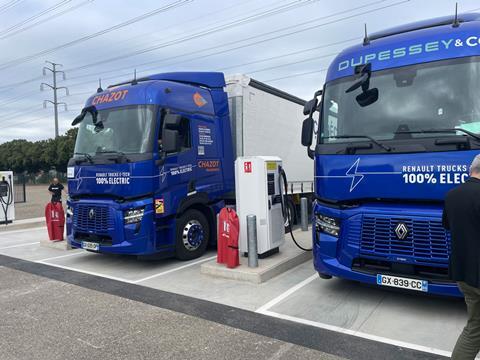
Renault is now producing two to three BEV Range T and C trucks a day at its Bourg-en-Bresse plant – all ordered by customers – and has the capacity to ramp up production to 15 a day as demand picks up. It has also put five BEVs into service transporting axles 70kms from Saint-Priest to Bourg-en-Bresse to prove that BEVs really can do a proper job and not just be green window dressing.
Emmanuel Duperray, senior vice president for electromobility, said that up to June 2024 Renault had produced 1,317 E-Tech T and C BEVs which had now covered over 20m kms, avoiding 20,000kgs of CO2 emissions.
The OEM is committed to becoming carbon neutral in its manufacturing operations by 2040 and to switch 50% of vehicle production to zero emissions by 2030 and 100% by 2050.
But Duperray said the company was “still developing diesel engines” to cut their fuel consumption and reduce emissions and the company “was not 100% sure” what its fuel mix would be by 2040. “But I am sure that BEVs will represent a very large majority of solutions for decarbonising road freight transport,” he added. “Hydrogen will only be there in certain applications and will play quite a small part.”
Marc Lejeune, Renault Trucks business intelligence director, agreed saying that analysis by the company indicated that BEVs would be able to decarbonise the vast majority of road freight applications, with only a handful of niches requiring biofuels, which would be in high demand from hard to decarbonise sectors such as marine and aviation, or hydrogen.
“Biomethane is very expensive so not a serious solution for trucks,” he opined. “Green hydrogen in the next decade will be mainly used to replace fossil fuels in industry. For trucks hydrogen consumes more energy than batteries so will only be used where BEVs are not relevant from an operational point of view.”
For these niche heavy duty applications Renault is planning a limited run of hydrogen internal combustion engines (HICE) and is part of joint venture developing fuel cell technology.
To reduce the use of natural resources Renault has established a Used Trucks “factory” to rebuild and repurpose vehicles after their first life, by for example turning tractor units into rigid vehicles.
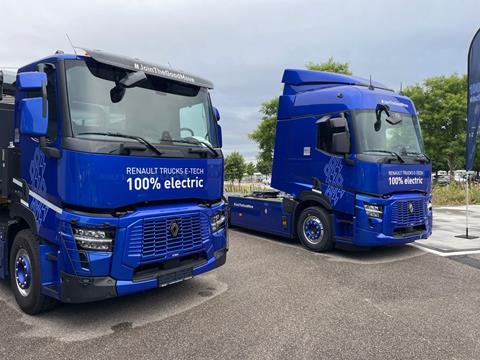
Lejeune said the company had opened in May 2024 “the first battery repair centre” in Sweden to repurpose vehicle batteries at the end of their useful life for use in storage systems. “This will pick up speed in 2026 and 2027,” he said. “We are developing storage systems from 200kWh to 2,000kWh. All our batteries will be recycled.”
Battery buffer storage may be necessary for operators whose depots do not have enough incoming grid power to fast change electric vehicles.
Francois Savoye, vice president for Renault Trucks’ electromobility solution offer, said that Renault now had the widest range of BEVs of any OEM, with vehicles between 650kg and 60 tonnes GCW that covered “90% of European applications”.
The company had already produced 2,000 E-Tech D models and began production of the larger T and C models last year. The E-Tech T is available with 330kW to 490kW motors and 360kWh to 540kWh battery packs, giving a range of up 300kms on a single charge and 500kms with a one-hour intermediate fast charge. To charge the batteries from 20% to 100% would take eight hours with an AC 43kW charger but only 100 minutes with a DC 250kW fast charger. The T is now available as a tractor in 4x2 and 6x2 tag axle configurations and as a rigid as a 4x2, 6x2 and 8x4 tridem.
Savoye said Renault “did not over-promise on range” and the E-Tech T could “cover 20% to 30%” of applications. In real-world operations on 83% of days the vehicles used less than half their battery capacity.
“We don’t want to get into a range race,” he added. “Bigger batteries penalise the total cost of operation, payload and the environmental equation.
“The best battery is the smallest possible battery. You cannot disconnect the battery from the charging. We prefer a small battery charged more often.”
Nevertheless Renault is moving from a conventional power train using a single motor, Optidrive gearbox and propshaft to an e-axle configuration that will allow up to 800kWh of batteries to be fitted between the chassis rails, increasing range to close to 600kms. “This will be for long haul applications and will not replace the current range because there are lots of applications where 300kms is adequate,” Savoye said. “We see 600kms as a plateau and do not believe 800kms or 1,000kms range is relevant. 600kms is right for a driver’s normal working day.”
Patrick Schuster, global head of road logistics strategy and sales development at Renault customer Kuehne + Nagel, pictured centre, said the Swiss logistics giant had recognised the need to decarbonise as far back as 2016 and had reduced its emissions 33% since then.
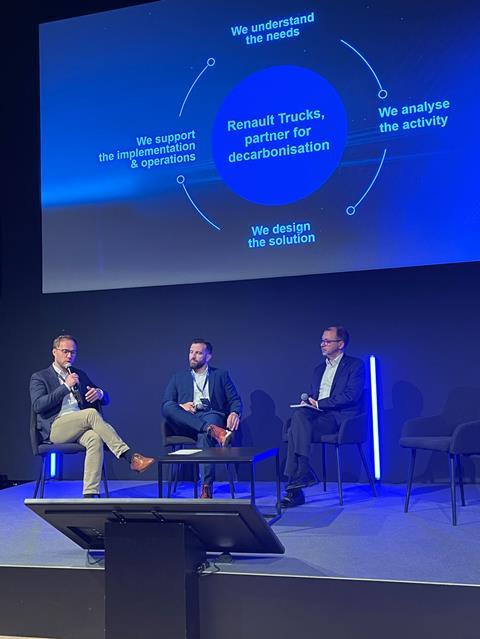
K+N started using BEVs three years ago and plans to electrify 60% of its own fleet by 2030. Schuster admitted that so far it had been a “bumpy ride” but dismissed hydrogen ICE as “a stupid idea” as in his opinion it would be “far too expensive”.
“We are super happy to decarbonise with BEVs,” he said. But the main barrier to their adoption in Germany, one of K+N’s main road markets, was the slow pace of upgrades to its depots’ power supplies to allow fast charging.
“There are 300 private power suppliers in Germany,” Schuster said. “We are happy about the right-sizing of the battery - but can we charge the trucks? Charging is the biggest barrier because there is no capacity. Charging a big truck takes 48 hours and that is not possible.”
He called upon politicians to act to remove this barrier to faster decarbonisation. “We all need to move together and that starts with politics,” he said.
With more 60% of the transport industry made up of small hauliers, Schuster also expressed concern about how K+N’s subcontractors, who often run fewer than six vehicles, are going to afford BEVs. “We have gained lots of experience over the last three years and are sharing that with our customers and carriers,” he said. “Our subcontractors own most of the trucks and by the end of the year we will integrate them into our network.”
He said electrical infrastructure would be “a big investment” for K+N and that so far few customers were willing to share that cost to reduce emissions from their logistics operations.
To demonstrate the effectiveness of BEVs, Renault Trucks is aiming to go 100% fossil fuel free on its own internal transport operations by 2030, said electromobility solutions sales director John-Phillipe Kretz.
Renault Trucks has four manufacturing and assembly plants in France:
- Blainville-sur-Orne - medium duty diesel, gas and electric truck assembly and stamping, welding, painting and trimming of all cabs
- Bourg-en-Bresse - heavy duty truck assembly and used trucks factory
- Vénissieux – engine assembly, pressed parts and spare parts
- Saint-Priest – axle assembly
Its Samsung battery cells are made in Hungary and assembled into packs at the Volvo Group plant in Ghent, Belgium.
The first inter-factory route to go all electric is the transfer of axles from Saint-Priest near Lyon to Bourg-en-Bresse, 90kms away. The next, much more ambitious route to go electric will be delivery of cabs from Blainville on the north coast to Bourg, a distance of over 600kms.
Kretz said that finding the right charging solution had been the “major roadblock” to the project, which had aimed to make the shift from diesel to electric vehicles at the lowest possible cost. Taking diesel vehicles operated for four years as a base cost, depreciating the BEVs over the same period came in 40% more expensive. By extending the period to six years, the cost premium came down to 12%. The infrastructure cost has been spread over an even longer period to further reduce the price premium over diesel.
When French government subsidies are taken into the equation the annual cost of going electric was calculated at just 5% more than running on diesel.
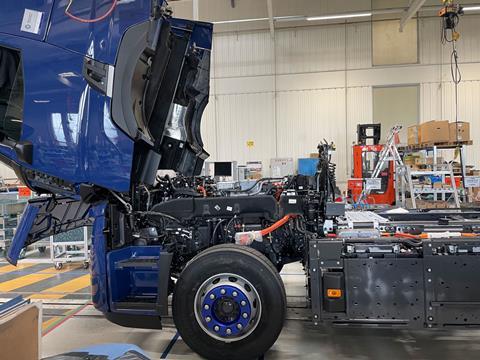
Kretz insisted that these costs where based on the trucks’ full retail price and the electricity used at Saint-Priest being sold at a 40c per kWh premium over Renault’s supply tariff, so they are what most operators can expect to achieve.
Renault uses two hauliers, Chazot and Dupessey &Co, to run the five 4x2 E-Tech T tractors which each complete two return trips per day. They recharge overnight at their home depots and get an intermediate 45-minute fast charge at Saint-Priest while they are loaded with 22 tonnes of axles in the drivers’ break. France allows 44 tonnes GVW on five axles for BEVs so 6x2 tractors are not required on this route.
They run almost empty on the return leg, carrying only a couple of tonnes of empty stillages. One depot had to have its power connection upgraded to charge the trucks overnight and this was fast tracked by the local network operator to allow the project to begin on time in June 2024.
The operation is just in time and the assembly plant only carries enough axles for an hour’s production. To ensure complete reliability of the top-up charging Renault has installed two power modules, each of which connect to two of the four 350kW chargers serving the three charging bays. The charging stations are supplied by Mobilize and E-Totem.
Kretz said that the project revealed how complex switching to BEVs can be and that customers and drivers would need lots of support and training. The drivers have a mobile phone app which gives time real-time information on their vehicles’ state of charge. Optifleet is used to monitor the vehicles and their power consumption.
“Moving from diesel to electric is not just about charging a truck,” said Kretz. “That is where Renault can help by sharing our experience. We walk the talk.”
Oxygen for the city
Also on show at Saint-Priest was Renault Trucks’ latest E-Tech model, the Oxygen. Developed in association with Geodis, it is purpose-built BEV designed specifically for urban operations, with the powertrain moved behind the integrated cab to allow a low flat floor giving easy two-step access to the nearside.
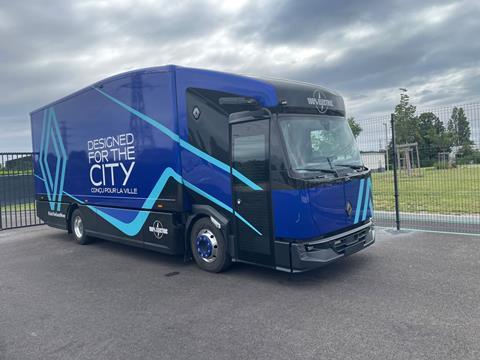
The driver’s direct vision is enhanced by a clear sliding bus-type nearside door and it is fitted with Renault’s new Digital Mirror Camera System replacing the mirrors, plus a 360-deg 11-camera monitoring system to give the driver a complete view around the vehicle on the 15-inch display screen. The DCMS will soon be made available as an option on Renault’s T range.
The example on show was plated at 16 tonnes giving a 6-tonne payload. Under the skin it is based on an E-Tech D chassis, though it uses 200kWh of the latest generation 2 batteries to give a range of 150kms. These new batteries provide 94kWh per battery, up from 60kWh in the previous generation.
A second Oxygen truck, a 6x2 26-tonner equipped with a refrigerated box, will start testing in October 2024 in collaboration with Dutch supermarket chain Jumbo and its logistics partner SVZ in Amsterdam.














